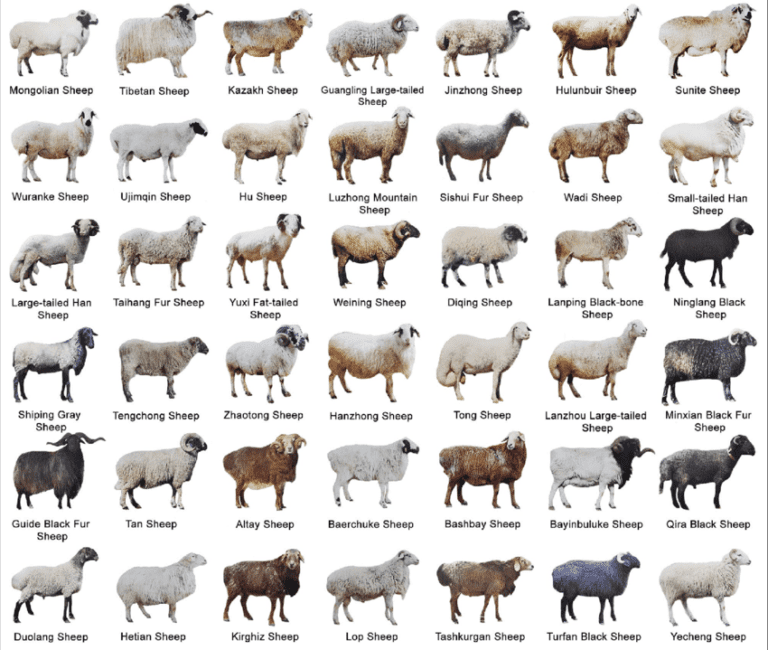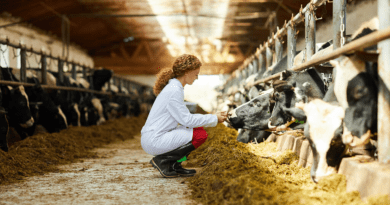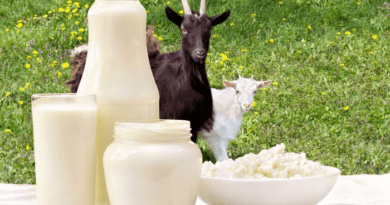Breed Characteristics for Selecting Sheep
There are four main or major breeds of sheep in Nigeria for instance and they include the following breeds of sheep: the West Africa Dwarf, Yankasa, Uda and Balami. One of their unique characteristics is that all of the above mentioned sheep breeds are hairy types.
The West Africa Dwarf sheep is a small, short-legged animal found in the humid zone of southern Nigeria. Animals vary in a coat color but black predominates. The males have horns while females are hornless.
It is the smallest of the Nigeria breeds, with a mature body weight of 18 to 25kg. Because the breeds thrive in areas that are heavily infested with tsetse fly, it is considered to be tolerated to trypanosomiasis.
The Yankasa sheep is the most numerous and is found throughout the Guinea and Sudan savanna zones. It has a predominantly white coat color, with black patches around the eyes, ear, muzzle (nose and mouth area) and hooves.
Mature rams have curved horns and heavy, hairy white mane. The females are hornless. It is a fine-looking breed, hardy and of medium body size. The adults reach weights of 30 to 40kg. It adapts well to intensive production and has a relatively high growth rate.
The Uda sheep is a large, long-legged breed with a convex facial profile, found in the Sudan savanna zone, especially in the North-western part of Nigeria. It has a characteristics pied coat color pattern of an entirely black or brown head and fore quarters and white hind-quarters.
The ears are large, long and droopy. Mature males have horns while females are normally hornless. The breed is particularly abated to extensive grazing and is renowned for its trekking ability. Mature animals weigh 35 to 45kg.
The Balami sheep is the biggest of the Nigeria sheep breeds and is found mainly in the drier Sudan and Sahel Savanna zones. It has an all white coat. Mature weights of 40 to 50kg are common.
Read Also: Ruminant Animal Wounds: Causes and Methods of Treatment
Experience has shown that the different breeds of sheep are adapted and perform best in their specific ecological zones. Because of the variations in the amount of rainfall, temperature and relative humidity, all of which indirectly affect performance, farmers are advised to raise those breeds that predominate in their ecological zones.
Thus, while the Yankasa and Uda are suitable for the Guinea and Sudan zone. The West Africa Dwarf and Yankasa breeds should be raised in humid Forest and Derived Savanna zones.
Sheep Selection and Breeding

Since life began, animals best adapted to their environment have survived and produced the largest number of offspring. For example, most breeds of sheep that originated in the British Isles survived only if they were born in the spring when the temperature was mild and feed was available. That is natural selection.
Selection should be a part of all breeding sheep production enterprises. It is effective for almost all the important economic traits in sheep. No selection program, however, can improve all these economically important traits at once.
Generally, the more traits involved in selection, the less improvement will result for a single trait. The first step in any selection program is to identify the traits of greatest economic importance. They may be growth rate, carcass merit, fleece traits, or reproductive efficiency.
The improvement that can be made depends on:
- Accurate measurement of the trait.
- Complete records on the flock.
- The amount of selection pressure applied.
- The amount of variation of the trait or different traits among individuals within the flock. If the sheep do not vary genetically, then no improvement can be made. If they vary greatly, then improvement will be rapid when producers select only the individuals that excel in the expression of important traits.
- The heritability of the trait. Variation in any economic trait is caused by genetic differences and environmental differences. Variation that results from differences in heredity is broadly defined as heritability.
Researchers have estimated the heritability (the ability to “pass on” traits to offspring) of the economically important traits (table 1). Generally, if the heritability estimate is less than 20 percent, progress is slow. A heritability estimate of 20 to 40 percent is considered medium. A heritability estimate greater than 40 percent is high.
Purebred breeders should be committed to improving the economically important traits of their breed. Their breed serves as a source of genetic material for crossbreeding and for improving the industry.
Read Also: Ways to Fatten Ruminant Aniamls Faster
On the other hand, commercial sheep producers might find it more profitable to crossbreed. Some economically important traits that can be improved only slowly within a breed can be improved more rapidly with effective crossbreeding. An example is rate of reproduction. By most estimates, the heritability of reproductive traits is low.
However, hybrid vigor (expression of a trait above the average of the dam and sire for that trait) exists for rate of reproduction. Generally, crossbred ewes exhibit a higher reproduction rate, produce more milk, and their lambs are stronger at birth.
Table (1)
| Heritability of traits in sheep | |
| Trait | Percent |
| Birth weight | 0.15 |
| Weaning weight (60 days of age) | 0.20 |
| Weaning weight (120 days of age) | 0.25 |
| Mature body weight | 0.40 |
| Rate of gain (post-weaning) | 0.40 |
| Face cover | 0.35-0.55 |
| Skin folds | 0.20-0.50 |
| Grease fleece weight | 0.25-0.60 |
| Clean fleece weight | 0.25-0.60 |
| Clean yield | 0.30-0.40 |
| Staple length | 0.30-0.65 |
| Fleece grade | 0.20-0.60 |
| Multiple birth | 0.10 |
| Milk production | 0.10 |
| Ewe productivitya | 0.20 |
| Loin-eye area | 0.35 |
| Fat thickness over loin eye | 0.30 |
| Carcass weight | 0.35 |
| Retail cut weight | 0.45 |
| Dressing percentage | 0.10 |
Sheep Selection Tools
Numerous tools are available for selection. The key is to combine operation goals with production benchmarks and visual appraisal to select the best sheep.
Sheep selection should involve more than just visual selection characteristics. There are a number of tools available for selection, but the key is to combine operation goals with production benchmarks and visual appraisal to select the best sheep for your farm. Plus, producers should take a look at an often overlooked part of the selection process: culling strategies.

Not all sheep are created equal and not all farms are created equal. Before you even walk out to the barn to look at the sheep, the first thing you should do is define your market.
Who are you selling to and what does your customer want? You will then be able to define what characteristics are important for your ewe flock to exhibit.
Then, step two is to evaluate current characteristics exhibited by your ewes and decide what traits need improved upon. You might take out a tablet and a pencil and write down what you feel are the 5 most important characteristics of your ideal ewe. Compare that to what is most important to your customer.
Does your operation have any goals and production benchmarks? What type of selection principles do you need to employ in order to reach those goals? Where are you at currently with production and how do you reach your benchmarks? After you answer those questions, add one more question into the mix.
Do you remember the typical job interview question “where do you want to be in 10 years?” This is a good time to sit down and think about what your sheep and your sheep operation should look like 10 years from now.
Let’s take a look at an example flock. This flock produces lambs for breeding stock. Buyers are looking for moderate sized sheep with good muscling, structural correctness and the ability to perform well on pasture.
The producer also wants to increase the lambing percentage so there are more lambs to sell. So, where does this producer start when selecting replacement ewes and rams to breed to the flock?
When the sheep are lambing, the producer should be tracking data such as birth weight, birth type and weaning weight. The producer can also record body condition scores at certain times throughout the year to assess a ewe’s ability to maintain body condition on pasture.
Because the buyers want heavy muscling, the producer can use ultrasound scanning to assess loin eye size and backfat thickness. Lighter muscled animals that don’t meet a minimum production benchmark can be sent to the sale barn.
The data collected by the scanner is also useful as a marketing tool to show buyers the amount of muscling in the animals. All the performance data mentioned so far can also be evaluated through NSIP/Lambplan to develop genetic breeding values that are a more accurate measure of performance.
Because the producer wants to increase lambing percentage, he or she may focus on selecting replacements that were born as twins. But, the producer also needs to be aware of other factors that affect twinning besides genetics. Nutrition is a very important part of the equation, so evaluation of feeds and feed quality will be important.
Read Also: Worm Infestation on Ruminant Animals: Symptoms and Treatment
The last step is for the producer to visually appraise the animals for structural correctness: level top, level dock, correct set to legs, strong pasterns. You should also consider body capacity and muscle shape and design. Short hipped, round muscled animals tend to walk with a short stride and can have problems at lambing time.
If your sheep have many hills in their pasture, freedom of movement can be very important. Purebred sheep should also exhibit certain breed characteristics. Refer to the breed standards for more information on what your breed of sheep should look like.
Once the sheep has passed all these selection parameters it is now ready for marketing. Think about what characteristics of your sheep and farm set you apart from others so that your customer prefers what you produce. Focus on those characteristics in your marketing efforts.
Let’s throw in a couple points on culling strategies. If there are families of ewes within your flock who never produce twins, perhaps it is time for them to hit the road. Young ewes will often produce just one lamb in their first pregnancy.
However, they should have the ability to produce twins once they are more mature. Or, is there some other reason why this ewe doesn’t produce twins? Is she normally too thin? Is she prone to internal parasites? A yes answer to either of these questions is certainly reason to cull this ewe and remove her genetics from the flock.
Sheep selection is an important part of building the genetics in your flock to meet your production goals. Set some production benchmarks that you want to achieve this year, in two years and even ten years down the road.
Read Also: Duties of Wildlife Administrators and Wildlife Protection Services









